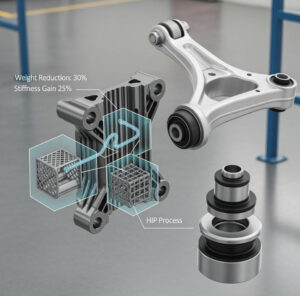custom surgical handles using metal 3D printing
Índice
Introduction – Precision in Surgeons’ Hands: The Significance of Ergonomic Surgical Handles
In the intricate world of surgical procedures, the tools surgeons wield are extensions of their skill and precision. Among these essential instruments, the surgical handle plays a pivotal role, directly influencing a surgeon’s grip, control, and overall dexterity. Ill-designed or generic handles can lead to discomfort, fatigue, and even compromise the accuracy of delicate maneuvers. This is where the advent of custom surgical handles, particularly those manufactured through advanced metal Impresión 3D techniques, marks a significant leap forward. By tailoring the handle’s design to the specific needs of the surgeon and the demands of the procedure, we can enhance surgical outcomes, reduce physical strain, and ultimately contribute to improved patient care. At Metal3DP, we understand the critical importance of high-quality, reliable surgical instruments. Our expertise in metal additive manufacturing allows us to produce custom surgical handles that meet the stringent demands of the medical industry, offering unparalleled precision and ergonomic benefits.
What are Custom Surgical Handles Used For? Enhancing Control and Dexterity in Medical Procedures
Custom surgical handles serve a multitude of critical functions across a wide spectrum of medical specialties. Unlike standard, one-size-fits-all handles, these bespoke instruments are engineered to optimize a surgeon’s interaction with various surgical tools, including scalpels, retractors, forceps, and specialized instruments used in minimally invasive procedures. The primary purpose of a custom surgical handle is to enhance:
- Grip and Control: Tailored to the surgeon’s hand size and shape, custom handles provide a more secure and comfortable grip, reducing the risk of slippage and improving control during intricate movements.
- Dexterity and Precision: An ergonomic design minimizes hand fatigue and allows for finer motor control, crucial for delicate surgical tasks.
- Procedure-Specific Requirements: Different surgical procedures demand varying levels of force, angle of approach, and manipulation. Custom handles can be designed with specific textures, lengths, and weights to meet these unique requirements.
- Reduced Strain and Fatigue: Prolonged surgical procedures can lead to hand strain and fatigue. Ergonomically designed handles distribute pressure evenly and promote a more natural hand position, mitigating these issues.
- Improved Accessibility: In minimally invasive surgery, specialized handles with unique angles or lengths can improve access to target areas.
Consider the impact in various medical fields:
- Neurocirugía: Precise control is paramount. Custom handles for micro-dissectors and nerve hooks can significantly enhance a neurosurgeon’s ability to navigate delicate neural structures.
- Cirugía ortopédica: Procedures involving bone manipulation often require handles that provide a firm grip and allow for significant force application. Custom designs can incorporate features for better leverage.
- Cirugía cardiovascular: Fine movements and steady hands are essential. Custom handles for delicate instruments used in cardiac procedures can improve accuracy and reduce tremor.
- Ophthalmic Surgery: Extremely precise movements are required. Lightweight, ergonomically designed handles for microsurgical instruments are critical for successful outcomes.
By providing surgeons with tools that feel like a natural extension of their hand, custom surgical handles contribute directly to enhanced surgical precision and improved patient outcomes. Metal3DP’s metal 3D printing services enable the creation of these highly specialized instruments with exceptional accuracy and material integrity.
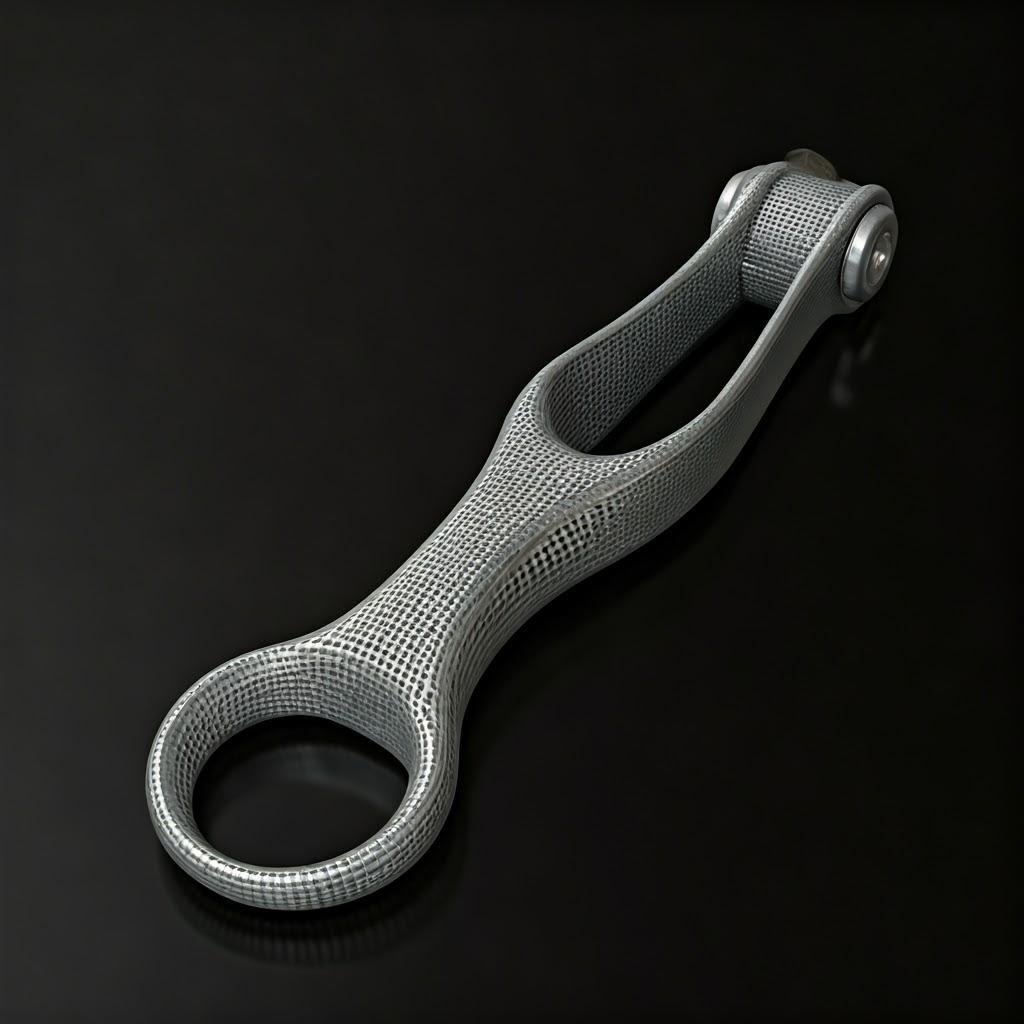
Why Choose Metal 3D Printing for Custom Surgical Handles? Advantages for Medical Device Manufacturing
The adoption of metal 3D printing, also known as metal additive manufacturing, offers a compelling array of advantages over traditional manufacturing methods for the production of custom surgical handles. These benefits are particularly significant in the demanding medical device industry:
- Libertad de diseño y complejidad: Metal 3D printing allows for the creation of intricate geometries and internal features that are simply not achievable with conventional methods like machining or casting. This design freedom enables the optimization of handles for ergonomics, grip, and specific functional requirements. Surgeons can collaborate with designers to create handles tailored precisely to their needs.
- Adaptación y personalización: The ability to produce unique designs without the need for expensive tooling makes metal 3D printing ideal for creating truly custom surgical handles. Variations in hand size, grip style, and procedural preferences can be easily accommodated.
- Creación rápida de prototipos e iteración: Metal 3D printing significantly accelerates the prototyping process. Design modifications can be quickly implemented and new iterations produced in a matter of days, allowing for rapid feedback and refinement by surgeons before final production. This agile approach is crucial for developing optimal ergonomic designs.
- Eficiencia del material: Additive manufacturing builds parts layer by layer, using only the material needed for the component. This reduces material waste compared to subtractive methods where material is removed from a solid block. For high-value medical-grade metals, this efficiency translates to significant cost savings, especially for complex designs.
- On-Demand Manufacturing and Scalability: Metal 3D printing enables on-demand production, eliminating the need for large production runs and warehousing. This is particularly beneficial for specialized surgical handles with lower volume requirements. As demand scales, multiple printers can be utilized to increase production capacity.
- Funcionalidad mejorada: 3D printing allows for the integration of features such as textured surfaces for improved grip, internal lattices for weight reduction without compromising strength, and even the incorporation of antimicrobial coatings during post-processing.
- High Material Performance: Metal 3D printing can process high-performance materials like stainless steel and titanium alloys, which offer the biocompatibility, strength, and corrosion resistance required for surgical instruments. Metal3DP’s advanced powder making system ensures the quality and consistency of these critical materials.
By leveraging the capabilities of metal 3D printing, medical device manufacturers and healthcare providers can access custom surgical handles that offer superior ergonomics, functionality, and material properties, ultimately benefiting both surgeons and patients.
Recommended Materials: 316L and Ti-6Al-4V for High-Performance Surgical Tools
The selection of the appropriate material is paramount in the manufacturing of surgical handles, as it directly impacts biocompatibility, strength, corrosion resistance, and the overall performance of the instrument. Two materials stand out as ideal candidates for metal 3D printed custom surgical handles: 316L stainless steel and Ti-6Al-4V titanium alloy.
Acero inoxidable 316L:
- Propiedades: 316L is an austenitic stainless steel known for its excellent corrosion resistance, particularly against chlorides and other aggressive environments encountered in surgical settings and sterilization processes. It possesses good tensile strength and ductility, making it suitable for instruments that require both robustness and the ability to withstand some deformation without fracturing. Its biocompatibility is well-established, making it a widely used material in medical devices.
- Advantages in Surgical Handles:
- Excelente biocompatibilidad: Minimizes the risk of adverse reactions with patient tissue.
- Alta resistencia a la corrosión: Withstands repeated sterilization cycles and exposure to bodily fluids.
- Buena resistencia y durabilidad: Ensures the handle can withstand the stresses of surgical procedures.
- Rentable: Generally more affordable than titanium alloys, making it a viable option for a wider range of applications.
- Facilidad de esterilización: Compatible with various sterilization methods commonly used in hospitals.
Ti-6Al-4V (Titanium Grade 5):
- Propiedades: Ti-6Al-4V is a titanium alloy renowned for its exceptional strength-to-weight ratio, excellent biocompatibility, and superior corrosion resistance compared to stainless steel. It is significantly lighter than steel, which can reduce surgeon fatigue during long procedures. Its high tensile strength and fatigue resistance ensure the longevity and reliability of surgical instruments.
- Advantages in Surgical Handles:
- Superior Biocompatibility: Often preferred for implants and instruments with prolonged tissue contact.
- Excelente resistencia a la corrosión: Offers greater resistance to a wider range of corrosive environments.
- Alta relación resistencia-peso: Results in lighter instruments that are easier to manipulate and reduce surgeon fatigue.
- Buena resistencia a la fatiga: Ensures the handle can withstand repeated use without failure.
- No magnético: Important for certain surgical procedures involving sensitive equipment.
The choice between 316L and Ti-6Al-4V for a custom surgical handle depends on the specific requirements of the surgical procedure, the surgeon’s preferences regarding weight and feel, and budgetary considerations. Both materials can be processed effectively using Metal3DP’s state-of-the-art SEBM printers, ensuring the production of high-quality, durable, and biocompatible surgical handles. Our team of experts can provide guidance on material selection to optimize the performance and cost-effectiveness of your custom designs.

Design Considerations for Additive Manufacturing of Surgical Handles: Optimizing for Functionality and Comfort
When designing custom surgical handles for metal 3D printing, several key considerations must be taken into account to ensure optimal functionality, ergonomics, and manufacturability. Unlike traditional manufacturing processes with their inherent limitations, additive manufacturing opens up a realm of design possibilities. Here are crucial aspects to consider:
- Ergonomics and Grip: The primary goal of a custom handle is to enhance a surgeon’s comfort and control. Design should focus on:
- Hand Size and Shape: Consider variations in hand dimensions and grip styles. Offering different sizes or even fully personalized designs based on hand scans can significantly improve comfort.
- Grip Texture: Incorporating textured surfaces, such as knurling, grooves, or strategically placed patterns, can enhance grip security, especially in wet or slippery conditions. The texture design should balance grip enhancement with ease of cleaning.
- Handle Shape and Contours: The overall shape should fit naturally in the hand, allowing for a secure and comfortable grasp during various surgical maneuvers. Contours and indentations can provide specific points of contact and leverage.
- Weight and Balance: The weight of the handle and its balance relative to the instrument it holds are critical for reducing fatigue and improving control. Metal 3D printing allows for internal lattice structures that can reduce weight without compromising strength.
- Functionality and Integration: The handle should seamlessly integrate with the surgical instrument it is intended for. Consider:
- Attachment Mechanism: The design must include a robust and secure mechanism for attaching the handle to the instrument. This could involve threads, slots, or other interlocking features. Precision in these features is crucial for a stable connection.
- Instrument Orientation: The handle design can influence the orientation and angle at which the instrument is held, which is critical for specific surgical approaches.
- Specialized Features: Depending on the procedure, the handle might incorporate features like finger rests, rotation mechanisms, or tactile indicators. 3D printing allows for the integration of these complex features directly into the design.
- Diseño para la Fabricación Aditiva (DfAM): Optimizing the design for the specific metal 3D printing process is essential for successful manufacturing:
- Orientación: The orientation of the part during printing can affect surface finish, support requirements, and mechanical properties. Careful consideration of the build orientation is necessary.
- Estructuras de apoyo: Overhanging features may require support structures during printing. The design should minimize the need for extensive supports and ensure they can be easily removed without damaging the part.
- Espesor de la pared y tamaño de las características: Ensure that the designed features meet the minimum wall thickness and feature size requirements of the chosen printing process.
- Internal Channels and Features: Metal 3D printing allows for complex internal geometries, such as cooling channels or weight-reducing lattices. These should be designed with consideration for powder removal and post-processing.
- Sterilization Requirements: Surgical instruments must withstand rigorous sterilization processes. The handle design should avoid sharp corners or intricate features that could trap contaminants and hinder effective cleaning and sterilization. The chosen material must also be compatible with the intended sterilization methods (e.g., autoclaving, chemical sterilization).
By carefully considering these design factors, engineers and surgeons can leverage the unique capabilities of metal 3D printing to create custom surgical handles that enhance precision, reduce fatigue, and ultimately improve surgical outcomes. Metal3DP’s expertise in metal additive manufacturing ensures that these complex design requirements can be translated into high-quality, functional surgical tools.
Achieving Precision: Tolerance, Surface Finish, and Dimensional Accuracy in 3D Printed Handles
In the realm of surgical instruments, precision is paramount. The tolerance, surface finish, and dimensional accuracy of custom surgical handles directly impact their fit, function, and the surgeon’s ability to perform delicate procedures with confidence. Metal 3D printing technologies have made significant strides in achieving the levels of precision required for medical applications.
- Tolerancia: Tolerance refers to the allowable variation in the dimensions of a manufactured part. For surgical handles, tight tolerances are crucial for ensuring a secure and precise fit with the corresponding surgical instrument. Metal 3D printing processes, particularly Powder Bed Fusion (PBF) techniques like Selective Laser Melting (SLM) and Electron Beam Melting (EBM), can achieve impressive tolerances, often in the range of ±0.05 mm to ±0.1 mm, depending on the material, part geometry, and build parameters. Factors influencing achievable tolerance include:
- Printer Accuracy: The inherent accuracy and calibration of the 3D printer.
- Contracción del material: Metals can shrink slightly as they solidify after melting. Precise control and understanding of material shrinkage are essential.
- Orientación de construcción: The orientation of the part during printing can affect dimensional accuracy due to factors like layer stacking and support structures.
- Post-procesamiento: Techniques like CNC machining can be employed as a secondary process to achieve even tighter tolerances on critical features.
- Acabado superficial: The surface finish of a surgical handle affects its feel in the surgeon’s hand, its cleanability, and potentially its interaction with tissue. Metal 3D printed parts typically have a surface roughness that depends on the powder particle size and the layer thickness used during printing. Common surface roughness values (Ra) for as-printed metal parts range from 5 to 20 µm. To achieve smoother surfaces required for medical applications, various post-processing techniques can be employed:
- Granallado: Using abrasive media to reduce surface roughness and create a more uniform finish.
- Pulido: Mechanical or chemical polishing methods to achieve very smooth, even mirror-like surfaces.
- Electropulido: An electrochemical process that smooths the surface and can also improve corrosion resistance.
- Precisión dimensional: Dimensional accuracy refers to how closely the printed part matches the intended design dimensions. Achieving high dimensional accuracy is critical for the proper functioning of surgical handles, ensuring they interface correctly with other instruments and fit comfortably in the surgeon’s hand. Factors influencing dimensional accuracy include:
- Compensación por diseño: Adjustments in the CAD model to compensate for predictable shrinkage or distortion during the printing process.
- Parámetros del proceso: Carefully controlled laser power, scan speed, and layer thickness in SLM, or beam current and scan speed in EBM.
- Calibración y Mantenimiento: Regular calibration and maintenance of the 3D printer are essential for consistent accuracy.
- Material Uniformity: The quality and consistency of the metal powder used in the printing process, such as those provided by Metal3DP’s advanced powder making system, play a significant role.
By carefully optimizing printing parameters, employing appropriate post-processing techniques, and utilizing high-quality metal powders, it is possible to achieve the stringent tolerance, surface finish, and dimensional accuracy required for custom surgical handles manufactured via metal 3D printing.
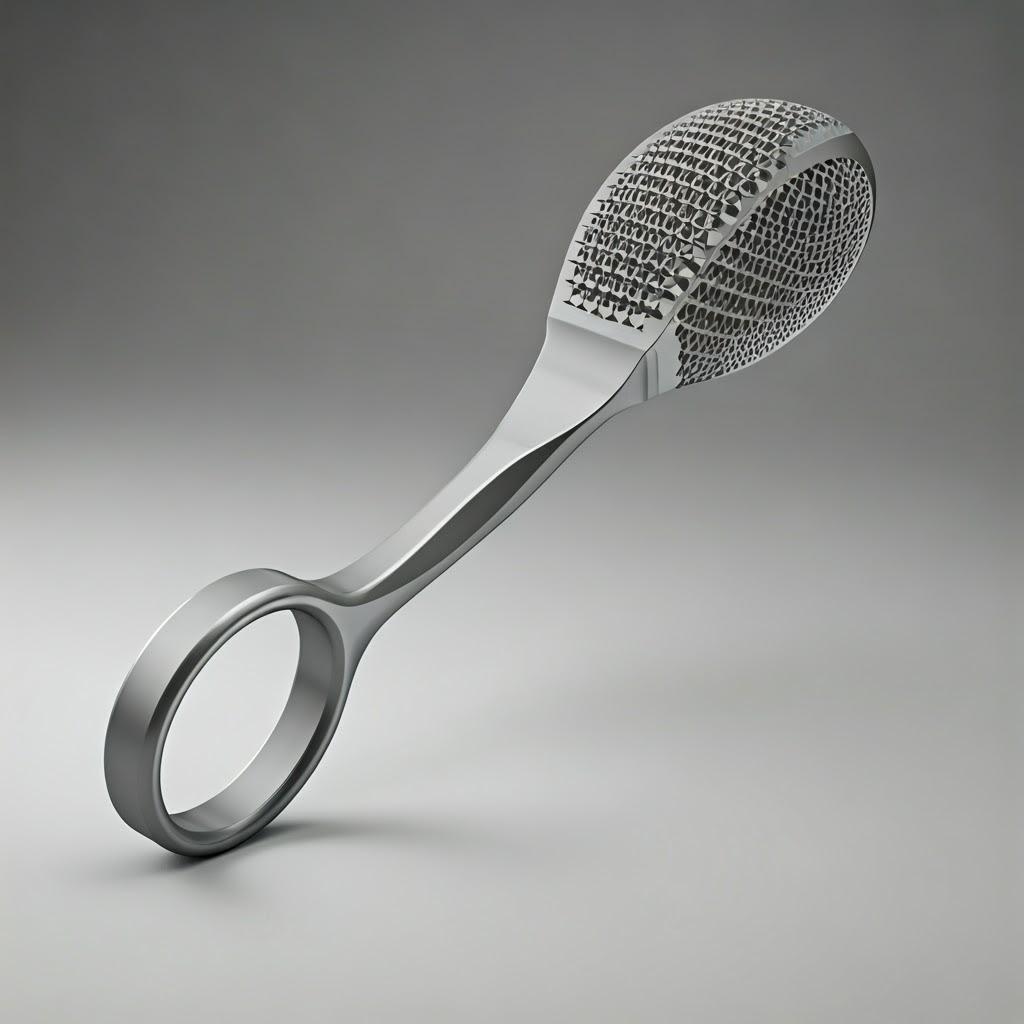
Post-Processing for Surgical Handles: Ensuring Sterility and Longevity
While metal 3D printing offers significant advantages in creating complex geometries for surgical handles, post-processing steps are crucial to ensure the final product meets the stringent requirements of the medical industry, particularly regarding sterility, biocompatibility, and longevity. Common post-processing requirements for 3D printed metal surgical handles include:
- Retirada del soporte: Support structures are often necessary during the printing process to support overhanging features and prevent distortion. These supports must be carefully removed without damaging the delicate features of the handle. Techniques include manual removal, machining, or chemical dissolution, depending on the material and support type.
- Acabado superficial: As discussed earlier, the as-printed surface finish may not be suitable for surgical applications. Post-processing techniques like media blasting, polishing (mechanical, chemical, or electropolishing), and vibratory finishing are used to achieve the desired smoothness, which improves cleanability, reduces friction, and enhances the aesthetic appeal.
- Tratamiento térmico: Depending on the metal alloy and the printing process, heat treatment may be required to relieve internal stresses, optimize mechanical properties (such as hardness and tensile strength), and ensure the material meets the required specifications for surgical instruments.
- Cleaning and Sterilization Preparation: Thorough cleaning is essential to remove any residual powder or contaminants from the printing process. This may involve ultrasonic cleaning, washing with specialized detergents, and rinsing. The handle must also be prepared for sterilization, ensuring that all surfaces are accessible and that the material can withstand the chosen sterilization method (e.g., autoclaving, dry heat, chemical sterilization).
- Revestimiento (opcional): In some cases, coatings may be applied to enhance the properties of the surgical handle. These could include:
- Revestimientos biocompatibles: To further improve the material’s compatibility with body tissues.
- Antimicrobial Coatings: To reduce the risk of infection.
- Hard Coatings: To increase wear resistance and extend the lifespan of the instrument.
- CNC Machining (Selective): For critical features requiring very tight tolerances or specific geometries that are difficult to achieve directly with 3D printing, selective CNC machining can be employed as a secondary process. This hybrid approach leverages the design freedom of 3D printing with the precision of traditional machining.
- Inspección y control de calidad: Rigorous inspection and quality control procedures are essential at each stage of post-processing to ensure that the final surgical handle meets all design specifications, material standards, and regulatory requirements for medical devices. This may involve dimensional measurements, surface finish analysis, and material testing.
By implementing appropriate post-processing steps, manufacturers like Metal3DP can transform raw 3D printed metal parts into high-quality, sterile, and durable custom surgical handles that meet the demanding needs of the medical profession. Our comprehensive approach to metal additive manufacturing includes optimized post-processing workflows tailored to specific materials and applications.
Navigating Challenges in 3D Printing Surgical Handles: Solutions for Optimal Outcomes
While metal 3D printing offers numerous advantages for producing custom surgical handles, several challenges can arise during the process. Understanding these potential issues and implementing appropriate solutions is crucial for achieving optimal outcomes in terms of quality, functionality, and cost-effectiveness. Common challenges include:
- Deformación y distorsión: Thermal stresses during the printing process can lead to warping or distortion of the part, especially for complex geometries or large parts.
- Soluciones: Optimizing part orientation, using support structures effectively, controlling the build chamber temperature, and implementing stress-relieving heat treatments post-printing can mitigate these issues. Design modifications to reduce sharp corners and large flat areas can also help.
- Support Removal Damage: Removing support structures can sometimes leave surface blemishes or even damage delicate features of the surgical handle.
- Soluciones: Designing self-supporting geometries where possible, using optimized support structures with minimal contact points, and employing careful removal techniques or dissolvable support materials can minimize damage.
- Porosidad y densidad: Achieving fully dense parts with minimal porosity is critical for the mechanical strength and biocompatibility of surgical instruments. Insufficient density can lead to weakened parts and potential issues with sterilization.
- Soluciones: Optimizing printing parameters (laser power, scan speed, layer thickness), using high-quality metal powders with good flowability (such as those from Metal3DP), and employing hot isostatic pressing (HIP) as a post-processing step can significantly reduce porosity and increase density.
- Rugosidad superficial: As mentioned earlier, the as-printed surface roughness may not be ideal for surgical handles.
- Soluciones: Employing appropriate post-processing techniques like media blasting, polishing, or electropolishing is essential to achieve the desired smooth surface finish.
- Exactitud dimensional y tolerancia: Achieving tight tolerances consistently can be challenging, especially for complex geometries.
- Soluciones: Accurate printer calibration, design compensation for material shrinkage, and potentially incorporating secondary machining processes for critical features can improve dimensional accuracy.
- Consistencia de las propiedades del material: Ensuring consistent mechanical properties throughout the printed part and across different builds is crucial for reliability.
- Soluciones: Using well-characterized and high-quality metal powders, maintaining stable printing conditions, and implementing robust quality control measures, including material testing, are essential.
- Coste y plazo de entrega: While 3D printing can be cost-effective for low-volume or highly customized parts, the cost per part and lead time can be higher than traditional manufacturing for large production runs.
- Soluciones: Optimizing part design for efficient printing, selecting the most appropriate printing technology and material for the application, and working with experienced metal 3D printing service providers like Metal3DP with efficient workflows can help manage costs and lead times.
By proactively addressing these potential challenges through careful design, optimized printing processes, appropriate post-processing, and rigorous quality control, manufacturers can successfully leverage metal 3D printing to produce high-quality custom surgical handles that meet the demanding requirements of the medical field.
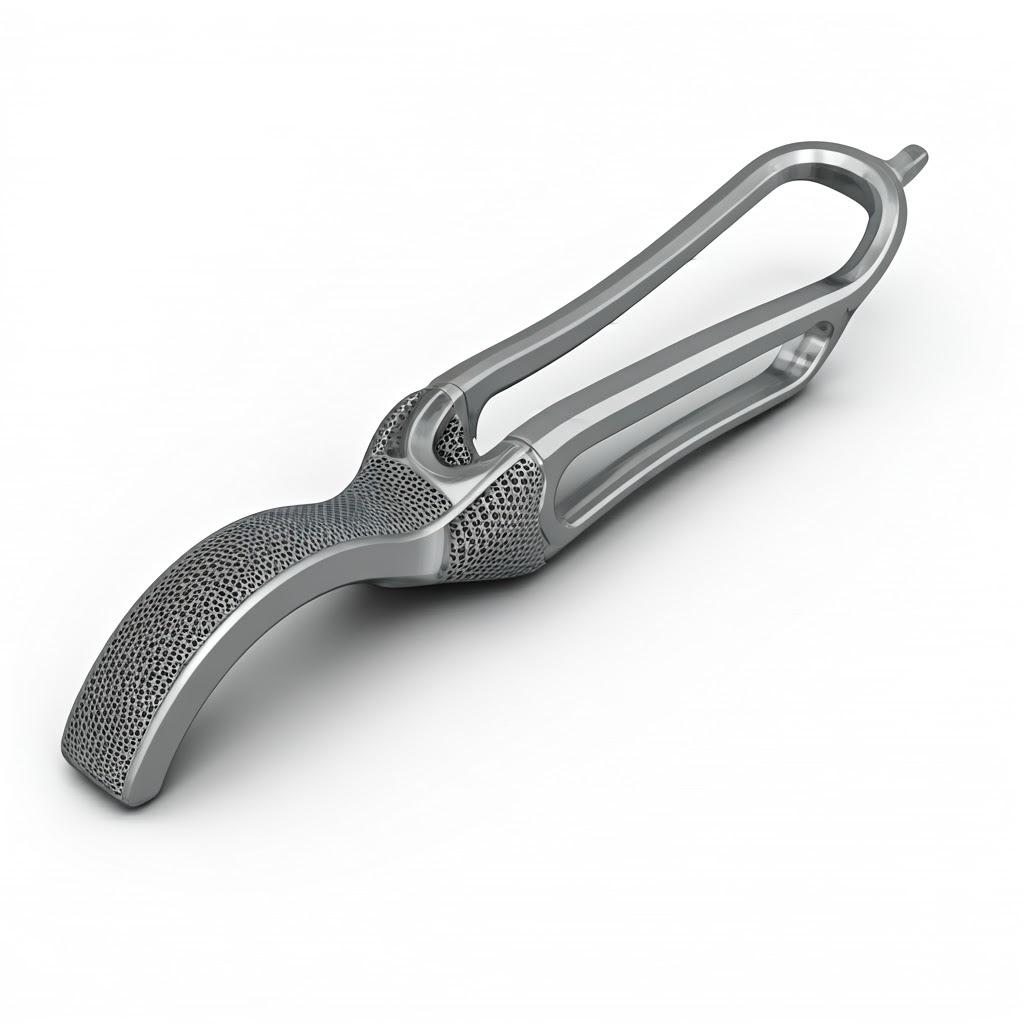
How to Choose the Right Metal 3D Printing Service Provider for Medical-Grade Handles
Selecting the appropriate metal 3D printing service provider is a critical decision for medical device companies and healthcare institutions seeking to produce high-quality custom surgical handles. The right partner will possess the expertise, certifications, and capabilities necessary to meet the stringent demands of the medical industry. Here are key factors to consider when evaluating potential providers:
- Industry Experience and Expertise: Look for a provider with a proven track record in manufacturing medical devices or components. Experience with biocompatible materials like 316L stainless steel and Ti-6Al-4V titanium alloy is essential. Inquire about their understanding of medical device regulations and quality standards. Metal3DP has extensive experience in providing additive manufacturing solutions for various industries, including medical, demonstrating our capability to handle critical applications.
- Capacidades de los materiales: Ensure the provider has experience processing the specific metal alloys required for your surgical handles (e.g., 316L, Ti-6Al-4V). They should be knowledgeable about the material properties, processing parameters, and post-processing requirements for these materials in medical applications.
- Printing Technology and Equipment: Different metal 3D printing technologies (e.g., SLM, EBM, DMLS) have varying strengths and limitations in terms of accuracy, surface finish, and material properties. Understand the technologies the provider utilizes and whether they are suitable for the complexity and precision requirements of your surgical handles. Metal3DP’s utilization of SEBM printers ensures high accuracy and material integrity for critical parts.
- Sistema de gestión de la calidad y certificaciones: A robust quality management system is crucial for medical device manufacturing. Inquire about the provider’s certifications, such as ISO 13485 (Medical devices — Quality management systems — Requirements for regulatory purposes). Compliance with relevant regulatory standards ensures the reliability and safety of the manufactured handles.
- Capacidades de postprocesado: As discussed earlier, post-processing is essential for surgical handles. Evaluate the provider’s in-house or partnered capabilities for support removal, surface finishing, heat treatment, cleaning, sterilization preparation, and any required coatings. A comprehensive suite of post-processing services streamlines the manufacturing process.
- Soporte de Diseño para la Fabricación Aditiva (DfAM): A knowledgeable service provider should be able to offer guidance on optimizing your surgical handle designs for the chosen 3D printing process. Their expertise in DfAM can help improve manufacturability, reduce material usage, and enhance the functionality of the final product.
- Tolerance and Accuracy Capabilities: Understand the tolerances and dimensional accuracy the provider can consistently achieve with their equipment and processes. Request sample parts or case studies that demonstrate their capabilities in producing parts with the required precision for surgical applications.
- Scalability and Production Capacity: Consider your potential future needs. Can the provider scale up production if your demand increases? Ensure they have sufficient printing capacity and resources to meet your anticipated volumes.
- Communication and Customer Support: Effective communication and responsive customer support are vital for a smooth collaboration. Assess the provider’s responsiveness, technical expertise, and willingness to work closely with you throughout the design, prototyping, and production phases.
- Coste y plazo de entrega: While quality and compliance should be primary considerations, cost and lead time are also important factors. Obtain clear and transparent pricing information and realistic lead times for your project. Understand the factors that influence cost, such as material, complexity, and post-processing requirements.
By carefully evaluating potential metal 3D printing service providers based on these criteria, you can select a partner like Metal3DP that can reliably produce high-quality, medical-grade custom surgical handles that meet your specific needs and regulatory requirements.
Understanding Cost Factors and Lead Time for Custom Medical Device Manufacturing
The cost and lead time associated with manufacturing custom surgical handles using metal 3D printing are influenced by a variety of factors. Understanding these elements is crucial for budgeting and planning your medical device development and production.
Factores de coste:
- Costes de material: The type and quantity of metal powder used significantly impact the overall cost. Materials like titanium alloys are generally more expensive than stainless steels. Complex designs that require more material or extensive support structures will also incur higher material costs. Metal3DP’s range of high-quality metal powders are priced competitively based on material grade and market demand.
- Tiempo de impresión: The duration of the printing process depends on factors such as the part’s size, complexity, build volume utilization, and layer thickness. Longer print times translate to higher machine operating costs (energy consumption, maintenance).
- Costes de postprocesamiento: The extent and complexity of required post-processing steps significantly affect the final cost. Support removal, surface finishing (e.g., polishing, electropolishing), heat treatment, and any specialized coatings add to the overall manufacturing expenses.
- Complejidad del diseño: Intricate designs that require significant engineering effort for optimization and support generation may incur higher design and pre-processing costs.
- Cantidad y tamaño del lote: While 3D printing is often cost-effective for low to medium volumes and highly customized parts, the cost per unit may decrease with larger batch sizes due to economies of scale in setup and post-processing.
- Equipment and Overhead Costs: The service provider’s investment in 3D printing equipment, software, facility, and personnel contributes to their pricing structure. Providers with advanced equipment and expertise may have higher rates but can often deliver superior quality and faster turnaround times.
- Control de calidad y pruebas: Rigorous quality control procedures, including material testing and dimensional inspection, are essential for medical devices and contribute to the overall cost.
Factores del plazo de entrega:
- Diseño e ingeniería: The initial design phase, including CAD modeling, optimization for 3D printing, and any necessary simulations, can influence the overall lead time.
- Material Procurement: If specialized metal powders are required and not readily available, material procurement can add to the lead time. Metal3DP maintains a stock of commonly used high-performance metal powders to minimize delays.
- Tiempo de impresión: As mentioned earlier, the actual printing duration is a key component of the lead time.
- Duración del post-procesamiento: The time required for support removal, surface finishing, heat treatment, and other post-processing steps varies depending on the complexity and the chosen methods.
- Quality Inspection and Testing: Thorough quality checks and testing can add to the overall lead time but are crucial for ensuring the safety and efficacy of medical devices.
- Scheduling and Capacity: The service provider’s current workload and printing capacity can affect the turnaround time. Choosing a provider with sufficient capacity and efficient scheduling processes is important.
By carefully considering these cost and lead time factors and discussing them transparently with your chosen metal 3D printing service provider, you can develop realistic budgets and timelines for the manufacturing of your custom surgical handles. Contacting Metal3DP for a detailed consultation and quotation will provide you with specific insights based on your project requirements.
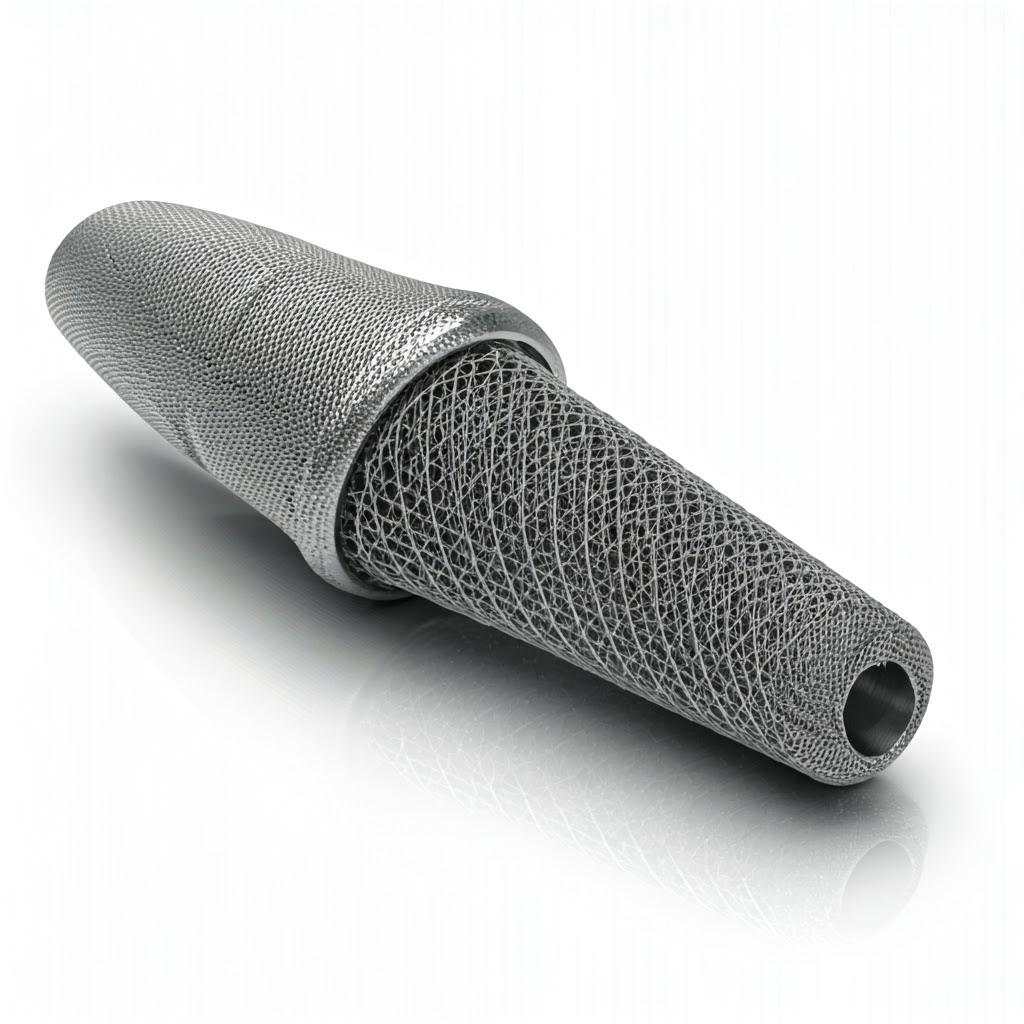
Frequently Asked Questions (FAQ) about 3D Printed Surgical Handles
Here are some frequently asked questions regarding the use of metal 3D printing for custom surgical handles:
- Are metal 3D printed surgical handles biocompatible? Yes, when manufactured using biocompatible materials like 316L stainless steel and Ti-6Al-4V, and when proper post-processing and sterilization procedures are followed, metal 3D printed surgical handles can be fully biocompatible and safe for use in medical procedures. It is crucial to choose materials and manufacturing processes that meet relevant medical device standards.
- Can custom surgical handles be sterilized? Absolutely. Metal surgical handles produced via 3D printing using appropriate materials can withstand common sterilization methods such as autoclaving, dry heat sterilization, and chemical sterilization. The design should avoid features that could impede effective sterilization.
- What level of precision can be achieved with metal 3D printed surgical handles? Metal 3D printing technologies like SLM and EBM can achieve high levels of dimensional accuracy and tight tolerances, typically in the range of ±0.05 mm to ±0.1 mm. Post-processing techniques like CNC machining can further enhance precision for critical features. The achievable surface finish depends on the printing process and post-processing methods employed.
- How does the cost of 3D printed custom surgical handles compare to traditionally manufactured ones? For low to medium volumes and highly customized designs, metal 3D printing can be more cost-effective than traditional manufacturing methods that require expensive tooling. The cost-effectiveness is especially pronounced when complex geometries or personalized features are involved. For very high production volumes of standardized designs, traditional methods may still be more economical.
- What is the typical lead time for producing custom surgical handles using metal 3D printing? Lead times vary depending on the complexity of the design, material availability, printing time, and post-processing requirements. Prototyping can often be done relatively quickly (within days or weeks), while larger production runs may take longer. Discussing lead times with your chosen service provider is essential for project planning.
- Can design iterations be easily accommodated with metal 3D printing? Yes, one of the significant advantages of 3D printing is the ease of design iteration. Modifications to the CAD model can be quickly implemented, and new prototypes can be produced without the need for new tooling, significantly accelerating the design and development process.
Conclusion – Empowering Surgeons with Advanced Metal 3D Printing Solutions
The integration of metal 3D printing into the manufacturing of custom surgical handles represents a transformative advancement in medical device technology. By offering unparalleled design freedom, material versatility with options like 316L and Ti-6Al-4V, and the ability to create highly ergonomic and precisely tailored instruments, metal additive manufacturing empowers surgeons with tools that are an extension of their skill and expertise.
En Metal3DP Technology Co., LTD, we are at the forefront of providing comprehensive metal additive manufacturing solutions, from advanced powder development to high-performance 3D printing equipment. Our commitment to quality, precision, and innovation enables us to partner with medical device companies and healthcare providers to develop and produce custom surgical handles that meet the most demanding requirements.
By embracing the capabilities of metal 3D printing, the medical industry can achieve:
- Enhanced Surgical Precision and Control: Through ergonomically optimized and custom-fit handles.
- Reducción de la fatiga del cirujano: Leading to improved focus and performance during long procedures.
- Faster Design and Development Cycles: Accelerating the introduction of innovative surgical tools.
- Cost-Effective Production for Customization: Making personalized instruments more accessible.
We invite you to explore how Metal3DP’s expertise and cutting-edge technology can contribute to your organization’s additive manufacturing goals in the medical field. Contact us today to discuss your specific needs and discover the potential of custom metal 3D printed surgical handles.
Compartir
MET3DP Technology Co., LTD es un proveedor líder de soluciones de fabricación aditiva con sede en Qingdao, China. Nuestra empresa está especializada en equipos de impresión 3D y polvos metálicos de alto rendimiento para aplicaciones industriales.
Solicite información para obtener el mejor precio y una solución personalizada para su empresa.
Artículos relacionados
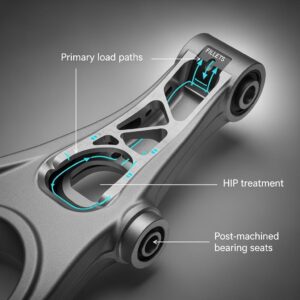
Metal 3D Printing for U.S. Automotive Lightweight Structural Brackets and Suspension Components
Leer Más "Acerca de Met3DP
Actualización reciente
Nuestro producto
CONTACTO
¿Tiene alguna pregunta? ¡Envíenos un mensaje ahora! Atenderemos su solicitud con todo un equipo tras recibir su mensaje.







